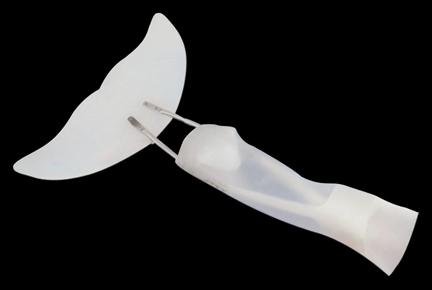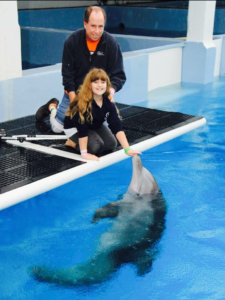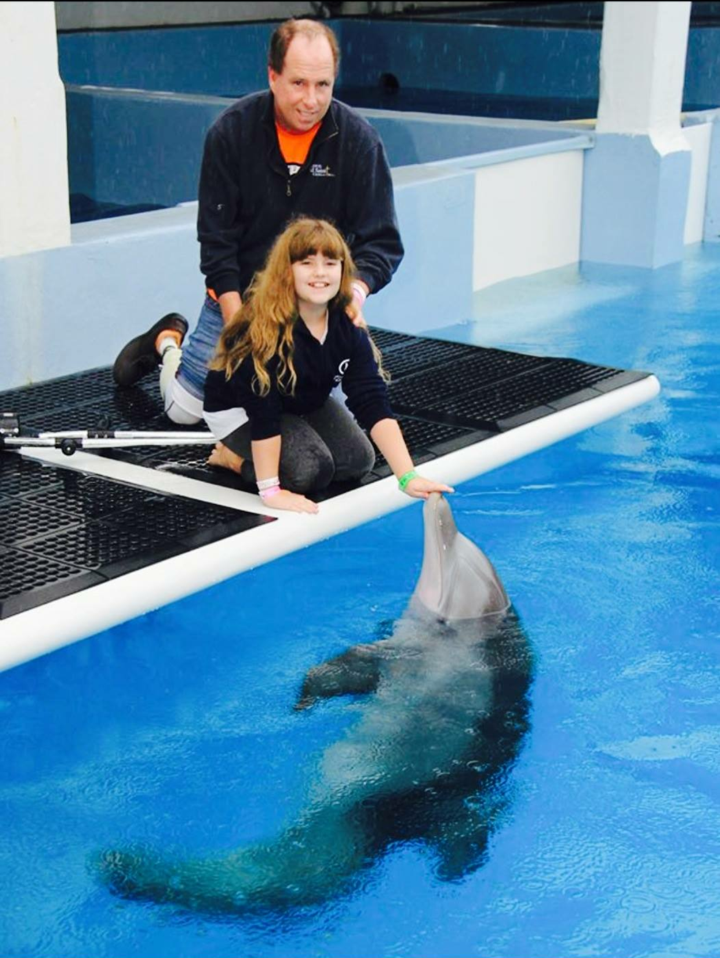A few years ago, I had the privilege of meeting a young girl who opened my eyes to the wonders of Winter the Dolphin, and her story.
For many of you, you may have heard a few details about this dolphin and her miraculous recovery. But, how many people are aware of how her story instills hope for people who have undergone amputations and their families?
Young Chloe Healy introduced me to this inspiring story of hope and courage.

Clearwater Marine Aquarium tells her story:
“Winter was found stranded in Mosquito Lagoon, near Cape Canaveral, Florida when she was only two months old, entangled in a crab trap line which cut off circulation to her tail flukes. After disentanglement, she was transported to Clearwater Marine Aquarium for treatment of her extensive injuries. However, despite exhaustive efforts to promote healing, her tail deteriorated and could not be saved. Her story is unusual – most dolphins trapped in monofilament and crab trap lines do not survive. Despite overwhelming odds against survival, Winter’s energy and ability to adapt to her new physical form surpassed expectations. She recovered completely, adapted to a new swim pattern and learned to eat fish on her own… about 12 pounds a day!”
“Winter is missing her entire tail fluke and joint. Tail flukes are the powerhouse of the dolphin and are attached to the peduncle, the muscular part of the dolphin. To swim naturally, a dolphin moves the peduncle up and down and the tail flukes propel the dolphin forward.”
Due to Winter losing her tail, she required a prosthesis, much like on that would be fitted to a person, in order to get around. Without her tail fluke and joint she would not be able to swim, and thus survive. A prosthetic tail and gel liner was designed by Dan Strzempka and fit on Winter by prosthetist Kevin Carroll.

Winter has proved to be such an inspiration to Chloe’s family, and to her father Dan, who lost his leg due to a blood clot which progressed into a below-the-knee amputation.
Twelve-year-old Chloe Healy explains it, “seeing this dolphin Winter overcome, proves that my father can overcome.”
“I related to Winter and I related my dad to Winter. Winter lost an important part of her, which was her tail, which she needed to survive. And I immediately thought of my dad.” When her father’s leg was amputated, he went through the emotional roller coaster that many amputees go through, asking himself looming questions,
“Will I be able to walk?”
“Can I go back to work?”
“If I can’t work, what will I do?”
Dan and Chloe first visited Winter prior to Dan’s surgery. That visit proved to be the security that he needed to feel comfortable in deciding to go along with the amputation surgery.
“If a dolphin can swim without its tail, he can walk without his leg,” says Chloe after that initial meeting with Winter.

After receiving his preparatory prosthesis, Dan and Chloe made the pilgrimage back to see Winter. This time with resolve and confidence. With the questions and fears of unknowing if Dan would be able to walk again behind him, he and Chloe shared the sentiment of perseverance and courage with Winter the Dolphin.
Chloe feels her dad is an inspiration to other amputees. Dan works full time and “lives his life like everyone else. He swims, he runs, he rides bikes, he works. I am proud of my dad and think of my dad when I am unsure if I can do something…he is an inspiration to me and to other people.”
Chloe is a sea creature and animal lover to the core. She is a regular and a research visitor at the Clearwater Marine Aquarium in Clearwater, Florida. She finds it inspiring and amazing to see people there visiting Winter who have limb loss or other physical disabilities. This Dolphin has become a pillar of hope for people trying to overcome and prevail. As a young environmental lover and activist, Chloe has the hopes of starting a marine biology club in her middle school and potentially in her local high school. She hopes this club will have a relationship with the Shedd Aquarium Marine Biology program in Chicago, IL.
Chloe is impressive with her enthusiastic desire to share her story and her father’s story with anyone who will listen. Check out this awesome audio that features Chloe as “Kid of the Week” on WGN.
Chloe shared with me that Bridget Coughlin, the CEO of Shedd Aquarium heard about Chloe on WGN and reached out to her about her father’s story. Chloe hopes that this meeting will result in a future visit by the marine biologists from the Shedd to her middle school’s club so that they can talk “about the oceans and what the oceans are going through right now.” She hopes to bring an awareness of this field to the students at her school.
As far as her future career in marine biology? Chloe has her future all figured out. She plans to attend the “University of Tampa because it is close to Clearwater, and get an internship and work with animal trainers in Clearwater” She plans on pursuing a “four-year degree in psychology, marine biology, and minor in environmental science.”
Chloe’s take-away message from her father’s experience is simple,
“You can do anything you put your mind to.”
“Don’t let anyone tell you can’t do something.”
“You are not different from anyone else. We are all people and we all deserve to be treated equally.”
“The only thing that holds you back is you.”
These are very wise words from a very wise girl. Thanks, Chloe, for being an inspiration to your dad, to me, and to the kids at your school, and to everyone who has the opportunity to hear you share your story.
Some of Chloe and my favorite Winter the Dolphin merchandise:
Dolphin Tale DVD
Dolphin Tale Blu-Ray
Dolphin Tale 2 DVD
Dolphin Tale 2 Blue-Ray
Hope For Winter – The True Story of a Remarkable Dolphin Friendship













